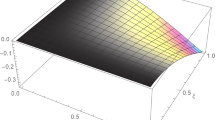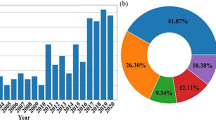Abstract
This paper studies global stability properties of the Rayleigh–Ritz approximation of eigenvalues of the Laplace operator. The focus lies on the ratios \(\hat{\lambda }_k/\lambda _k\) of the kth numerical eigenvalue \(\hat{\lambda }_k\) and the kth exact eigenvalue \(\lambda _k\). In the context of classical finite elements, the maximal ratio blows up with the polynomial degree. For B-splines of maximum smoothness, the ratios are uniformly bounded with respect to the degree except for a few instable numerical eigenvalues which are related to the presence of essential boundary conditions. These phenomena are linked to the inverse inequalities in the respective approximation spaces.






Similar content being viewed by others
References
Birkhoff, G., De Boor, C., Swartz, B.K., Wendroff, B.: Rayleigh–Ritz approximation by piecewise cubic polynomials. SIAM J. Numer. Anal. 3(2), 188–203 (1966)
Babuška, I., Osborn, J.E.: Eigenvalue problems. In: Finite Element Methods (Part 1), Volume 2 of Handbook of Numerical Analysis, pp. 641–787. Elsevier (1991)
Brenner, S.C., Scott, R.L.: The Mathematical Theory of Finite Element Methods, vol. 15, 3rd edn. Springer, New York (2008)
Cottrell, J.A., Hughes, T.J.R., Bazilevs, Y.: Isogeometric Analysis: Toward Integration of CAD and FEA. Wiley, London (2009)
Cottrell, J.A., Reali, A., Bazilevs, Y., Hughes, T.J.R.: Isogeometric analysis of structural vibrations. Comput. Methods Appl. Mech. Eng. 195, 5257–5296 (2006)
Dedè, L., Jäggli, C., Quarteroni, A.: Isogeometric numerical dispersion analysis for two-dimensional elastic wave propagation. Comput. Methods Appl. Mech. Eng. 284, 320–348 (2015)
Hughes, T.J.R., Cottrell, J.A., Bazilevs, Y.: Isogeometric analysis: CAD, finite elements, NURBS, exact geometry and mesh refinement. Comput. Methods Appl. Mech. Eng. 194, 4135–4195 (2005)
Hughes, T.J.R., Evans, J.A., Reali, A.: Finite element and nurbs approximations of eigenvalue, boundary-value, and initial-value problems. Comput. Methods Appl. Mech. Eng. 272, 290–320 (2014)
Hughes, T.J.R., Reali, A., Sangalli, G.: Duality and unified analysis of discrete approximations in structural dynamics and wave propagation: comparison of \(p\)-method finite elements with \(k\)-method NURBS. Comput. Methods Appl. Mech. Eng. 197(49–50), 4104–4124 (2008)
Peterseim, D., Schedensack, M.: Relaxing the CFL condition for the wave equation on adaptive meshes. J. Sci. Comput. (2017). doi:10.1007/s10915-017-0394-y
Schwab, C.: \(p\)- and \(hp\)-Finite Element Methods: Theory and Applications in Solid and Fluid Mechanics. Numerical Mathematics and Scientific Computation. Clarendon Press, Oxford (1998)
Strang, G., Fix, G.J.: An Analysis of the Finite Element Method. Prentice-Hall Series in Automatic Computation. Prentice-Hall Inc., Englewood Cliffs (1973)
Takacs, S., Takacs, T.: Approximation error estimates and inverse inequalities for B-splines of maximum smoothness. Math. Models Methods Appl. Sci. 26, 1411 (2016). doi:10.1142/S0218202516500342
Weyl, H.: Über die asymptotische Verteilung der Eigenwerte. Nachrichten von der Gesellschaft für Wissenschaften zu Göttingen, Mathematisch - Physikalische Klasse 1911(2), 110–117 (1911)
Zhang, Z.: How many numerical eigenvalues can we trust? J. Sci. Comput. 65(2), 455–466 (2015)
Author information
Authors and Affiliations
Corresponding author
Additional information
D. Gallistl is supported by the Deutsche Forschungsgemeinschaft (DFG) through CRC 1173. D. Peterseim and P. Huber are supported by DFG in the Priority Program 1748 “Reliable simulation techniques in solid mechanics. Development of non-standard discretization methods, mechanical and mathematical analysis” under the project “Adaptive isogeometric modeling of propagating strong discontinuities in heterogeneous materials” (PE2143/2-1). The authors acknowledge the support given by the Hausdorff Center for Mathematics Bonn.
Rights and permissions
About this article
Cite this article
Gallistl, D., Huber, P. & Peterseim, D. On the stability of the Rayleigh–Ritz method for eigenvalues. Numer. Math. 137, 339–351 (2017). https://doi.org/10.1007/s00211-017-0876-8
Received:
Revised:
Published:
Issue Date:
DOI: https://doi.org/10.1007/s00211-017-0876-8




